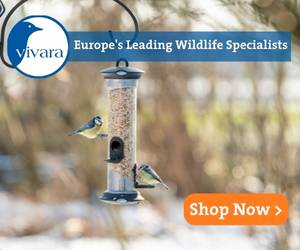
After feeding our garden birds, the next best way we can help them is to provide them with safe sites to nest and bring up their young.
On this page we’ve gathered some links and resources to help you provide nest boxes for your garden birds.
Why provide nest-boxes for garden birds?
Populations of many of Ireland’s bird species are in sharp decline, even for some of our most familiar garden birds. Much of this population decline is down to habitat degradation, due largely to changes in the way we manage and use land. The simple fact is that, thanks to people, there are less natural nesting locations available for birds. So one of the best ways we can help bird populations in our gardens is to provide them with alternatives.
Enjoying birds all year around
The principal goal of providing nest boxes is to help the birds, of course, but there’s a benefit for us too. By encouraging birds to stay in and around our gardens during the breeding season, we get to watch their comings and goings, and the connection with nature
What kind of nest box should I use?
There is a wide range of specialist nest-box styles available to suit specific bird species (treecreeper nest-boxes and house-martin nest-boxes for example) but if you’re just getting started, there are two types of generic nest-box that suit small Irish garden birds.
Hole-entrance nest-boxes
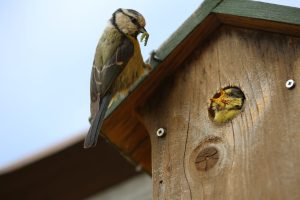
Hole entrance nest-boxes, as the name suggests, have a single small entrance hole cut out of the front panel. These are the typical nest-boxes you’ll find for sale in garden centres and online. Hole-entrance nest-boxes suit birds that naturally nest in cavities in old trees, or perhaps gaps in stone walls or in the eaves of buildings.
Several common Irish garden birds will use hole-entrance nest-boxes, with different sizes of entrance hole suiting different species of bird.
- A 25mm entrance hole will suit smaller species like Coal Tits and Blue Tits
- A 28mm entrance hole will work for the larger Great Tit
- A 32mm entrance hole will accommodate the slightly chunkier House Sparrow
- A 45mm entrance hole will attract larger hole-nesters like Starlings.
Open-fronted nest-boxes
The other style of box most commonly used in gardens is the open-fronted nest box. These are essentially the same as the hole-entrance nest boxes, but instead of a single entry hole, the top section of the front panel is removed completely to provide a large opening.
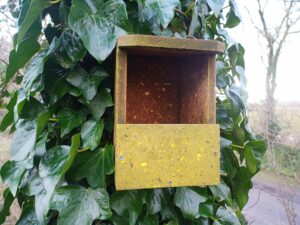
These kinds of boxes are suitable for species that typically build nests in shrubs and hedgerows: garden birds like robins, wagtails, wrens and, if you’re lucky, summer visitors like the spotted flycatcher will all use open-fronted nest-boxes.
What should I make my nest box out of?
Birds don’t really care what you make your nest-box out of. As long as it’s roughly the right size and shape, has the right opening, and provides the conditions they need, they’re not that fussy.
However, there are a couple of things you need to consider when choosing material to make nest boxes.
- Avoid potentially toxic materials: some man-made materials may seem ideal for nest-box construction, but you need to be sure they don’t contain substances that could leach into the box over time and prove toxic to birds, their eggs or their chicks.
- Choose a good insulator: the other thing to think about when choosing a material is its insulating properties. You want the nest box to keep the eggs/chicks relatively warm for a period when the adult bird leaves to find food. Conversely, on warmer days, you need the nest box to stay relatively cool to stop eggs and chicks overheating.
Wood is arguably the best choice for making your own nest-boxes. Any wooden plank or sheet around 15mm thick will work well (avoid pressure-treated timber, as leachates from the treatment can be toxic to birds).
Can I treat or paint my nest box?
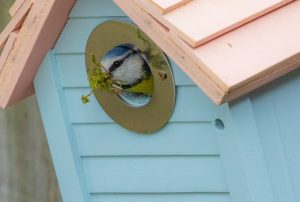
You can, but it’s important to use a non-toxic paint or stain. Make sure that whatever you use, once dry, won’t be toxic to the residents.
If you’re in any doubt, then it’s best not to treat/paint your nest box at all. This has the added advantage that your nest box will blend into its surroundings as it ages, making it potentially more attractive to birds, and less visible to predators.
Untreated boxes may not last as long, but material to build a new nest box is not expensive and they are easy to replace.
Where should I put my nest box?
Where you place your nestbox depends on the type of box you have, the bird species you’re catering for, and where you live.
- Hole-nesting species like Great Tits and Blue Tits favour boxes high in a tree (or on a wall, if there are no suitable trees available), generally between two to four metres up, out of reach of ground predators.
- Birds habituated to buildings, like House Sparrows and Starlings will readily use boxes situated high under the eves of houses.
- Birds like Robins and wrens, which use open-fronted nest boxes, prefer the boxes to be lower (between 1 and 1.5 metres or so off the ground) but because they’re lower, they need to be in dense cover, well hidden from potential predators.
- Space nest-boxes out — birds don’t usually choose to nest close together (House Sparrows are the exception here: they nest communally and will more readily use a “terrace” of three or four nest-boxes under the eaves of a house).
- Orientate your nest box with the entrance facing away from the prevailing wind (in Ireland this generally blows in off the Atlantic from the south-west, so face your nest-box roughly between north and east). This will both prevent wind-driven rain blowing into the box, and shade from it from direct sunlight during the hottest part of the day.
- Angle your nest box slightly downward – it will help protect the entrance from driving rain if the wind blows straight at the nest-box.
When and how should I clean my nest-box?
Well-designed nest boxes have a hinged panel (usually the front or the lid) that allows easy access for cleaning.
- Don’t open or try to clean a nest-box that’s in use.
- In autumn, when the last brood has long-since fledged and birds are no longer visiting the nest box (I usually leave it until early October) clean out the old nesting material and compost it or leave it to decompose under the nearest hedge.
- Rinse the box out with with boiling water to kill off any lingering parasites or eggs (DO NOT use any insecticides/pesticides).
- Allow it to dry thoroughly, then put it back in place.
It makes sense to leave your nest boxes up through the winter months. Small birds often use empty nest boxes to roost on cold winter nights, and it will mean birds are well used to the box and will be more likely to use it come spring.
What birds should I be trying to attract to my garden with nest boxes?
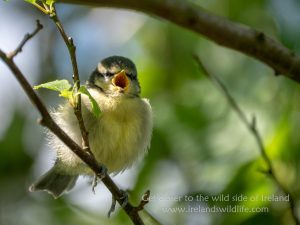
It makes the most sense to provide nesting boxes for birds that already visit your garden regularly. Catering for birds that already use your garden means your nest-boxes are more likely to be used.
If you know there are other species in the locality you’d like to entice into your garden, providing suitable nest boxes may help with that, just be prepared to wait a few seasons for them to find them.
When to put nest boxes up?
There is no bad time to put up a nest box. However, if you want birds to discover and possibly use your new nest-box quickly, putting it up in autumn or winter will increase your chances. It will give birds a chance to get used to the box before the start of the breeding season, and will mean the box is in situ when birds pair up and start investigating potential nesting sites in spring.
You can put new nest boxes up in spring and summer, and while you may get lucky, be prepared to wait until at least the following breeding season before birds pay them much attention.
It’s worth bearing in mind that nest-boxes can go unused for several seasons before birds occupy them. However, if you find a nest box isn’t being used over a few breeding seasons, there could be something about the location that’s just not ticking the right boxes for the birds. Try re-locating it in the autumn to a new location in the garden. You may have better luck.
Nest Box Advice From Bird and Wildlife NGOs
- The Birdwatch Ireland website has an excellent Garden Bird Nestbox FAQ here.
- The RSPB has some great resources on nest boxes for small birds.
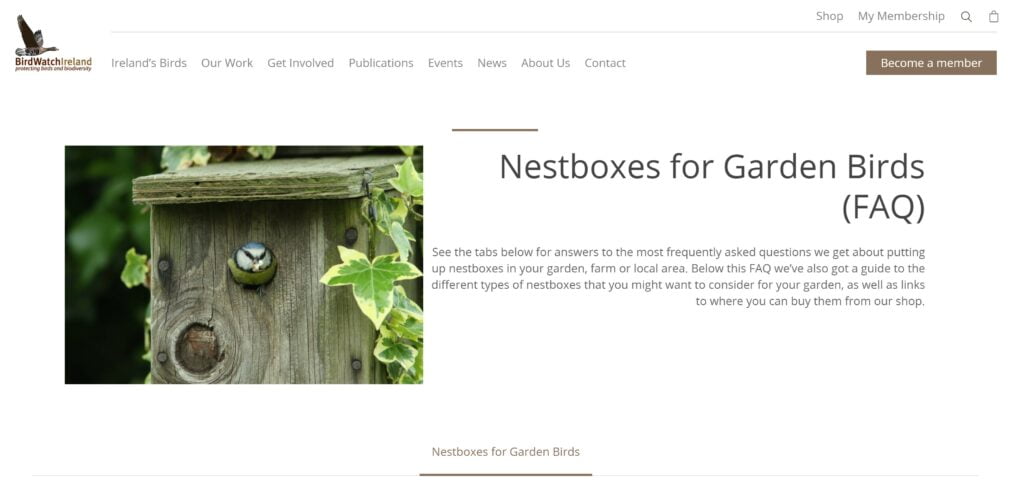
Build your own garden bird nest box
You’ll find lots of free plans online with measurements and instructions to build your own bird nest-boxes out of inexpensive and readily available materials. Just Google “Garden Bird nestbox plan” and you’ll be presented with a slew of options.
Here are a few to get you started:
- Download this handy Birdwatch Ireland nestbox-building factsheet (PDF)
- The RSPB Build A Bird Box Family Wild Challenge page has all the info you need to put together your own nest box and get the kids involved.
- The BTO Make A Nestbox page has advice and downloadable plans for a variety of nestboxes.
Where can I buy ready-made nest boxes?
We’ve made a few of our own nestboxes here at Ireland’s Wildlife. It’s fun and gives a great sense of satisfaction when birds use the boxes. We also use a selection of nestboxes from our Garden Wildlife Supplies partners at CJ Wildlife. The boxes are well designed and well made, and will last for years.
You can check out their full range of standard and specialist garden bird nestboxes here.





